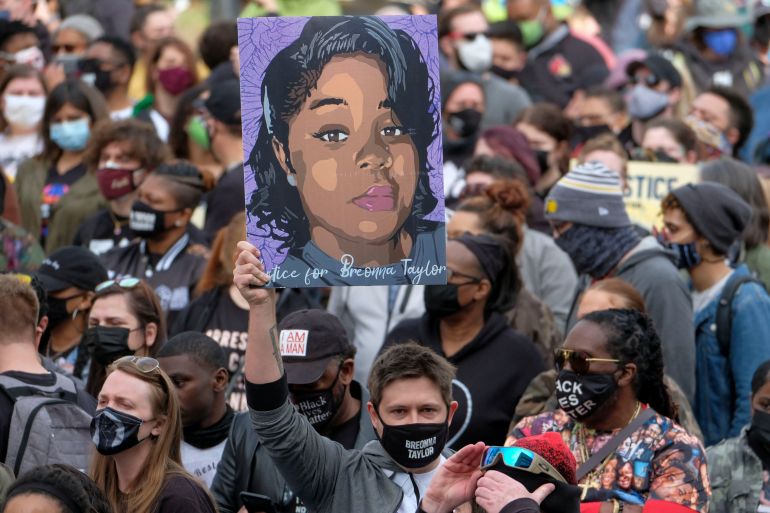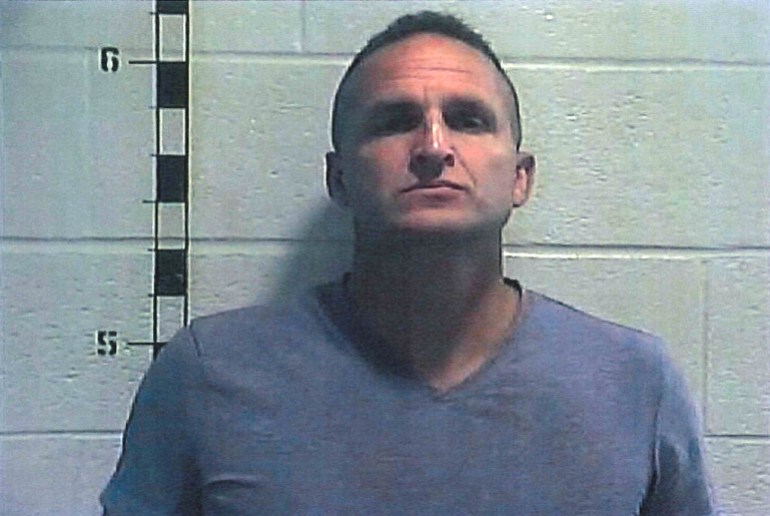Trial begins for ex-police officer charged in Breonna Taylor raid
Jurors are to tour Taylor’s apartment, hear testimony from police officer during trial expected to take two weeks.

The trial of a white former Kentucky police officer charged with wanton endangerment during the 2020 shooting death of Breonna Taylor began on Wednesday, casting a spotlight on another case in the United States that sparked a summer of protests against racial injustice two years ago.
Detective Brett Hankison, 45, whose stray bullets hit a neighbouring apartment in the city of Louisville during the botched execution of a search warrant in March 2020, was the only officer charged in the case.
Keep reading
list of 4 itemsUS police shooting of Black man in Georgia echoes Breonna Taylor
Protesters demand justice a year after Breonna Taylor killing
‘No stopping us’: The Black women fighting for Breonna Taylor
Prosecutors said the bullets endangered Taylor’s neighbours — a couple and their child. Hankison is charged with three counts of wanton endangerment, a low-level felony punishable by up to five years in prison.
Taylor, a 26-year-old Black woman was roused from bed when police kicked in the door of her apartment using a “no-knock” warrant. Police officers killed her when they returned fire after her boyfriend shot once, thinking intruders were entering the apartment. Police responded by firing 32 rounds, hitting Taylor six times. Taylor bled to death on the floor of her apartment, the police did not render aid.
No one has been charged in her death.
Assistant Kentucky Attorney General Barbara Maines Whaley, in her opening statement, told jurors that the case is not about the killing of Taylor, for which the city of Louisville paid a $12m wrongful death settlement to the slain woman’s family, an amount that would not bring her back. Nor, she said, is it about the decisions by police that led to the raid. She said the charges are focused on Hankinson’s decision to fire blindly through Taylor’s apartment, endangering her neighbours.

Before Taylor’s door was breached, Hankison had argued with a neighbour, telling him to get back inside. “This escalated the situation,” Whaley said. Then, once the shooting started, “He’s shooting in a different direction than the other two detectives,” she said.
Defence lawyer Stewart Mathews countered that Hankison was justified in what he did during a chaotic scene that lasted about 10 to 15 seconds from when Taylor’s door was breached to when the shooting stopped.
“There’s not going to be any dispute about the evidence,” said Mathews, in his opening argument. “The issue is, what was the reasoning behind his firing those shots?
“This case is not about the death of Breonna Taylor, but in a sense, it’s totally about that, because that’s what started this whole situation,” Mathews said. “Breonna Taylor was a peripheral part of this whole deal, but she was tied into it,” and their no-knock warrant meant officers had been approved to go inside.
Once Taylor’s boyfriend fired at the people breaking down her door and other officers fired back, Hankison “was attempting to defend and save the lives of his fellow officers who he thought were still caught in that fatal funnel inside that doorway”, Mathews said, “as he was taught to do – he was taught to shoot until the threat is stopped.”
Hankison fired 10 shots from outside the apartment and through a sliding glass patio door that had the blinds drawn. Some of his shots pierced the wall and entered the next-door home occupied by a child, a pregnant woman and a man.
Hankison told a grand jury that he opened fire once the shooting started. As he saw flashes light up the room, he said he mistakenly believed one of the occupants was holding an AR-15 or other long gun as his colleagues came under assault.
“I thought they were just being executed,” Hankison said of his fellow officers.
Instead, mostly what he heard was other police firing their weapons. Police Sergeant Jonathan Mattingly, who was wounded by Walker’s single shot, fired six times and Detective Myles Cosgrove fired 16 shots, the investigation found.
Calls to ban no-knock warrants intensified after the death of Taylor, who was not the subject of the search warrant. Kentucky enacted a partial ban last April.
Hankison’s trial in Jefferson County Circuit Court has failed to satisfy activists who believe police got off too easily after Kentucky Attorney General Daniel Cameron, the lead investigator, said police were justified in using deadly force.
A grand jury cleared the two white officers who actually shot Taylor but found reason to charge Hankison for endangering neighbours in the adjacent apartment.
The charge against Hankison, who pleaded not guilty, is a Class D felony punishable by up to five years in prison.
Judge Ann Bailey Smith swore in 10 men and five women as jurors and alternates to hear the case. The court declined to release information about their race or ethnicity.
Hankison’s jury was selected from a larger-than-normal pool because of the national publicity Taylor’s case has attracted since the deadly raid on March 13, 2020. Taylor’s name, along with George Floyd and Ahmaud Arbery — Black men who died in encounters with police and white pursuers — became rallying cries during racial justice protests seen around the world in 2020.
The 12 jurors and three alternates are expected to tour Taylor’s apartment and hear testimony from Hankison during the trial that’s expected to take two weeks. Several other current and former police officers are expected to testify.